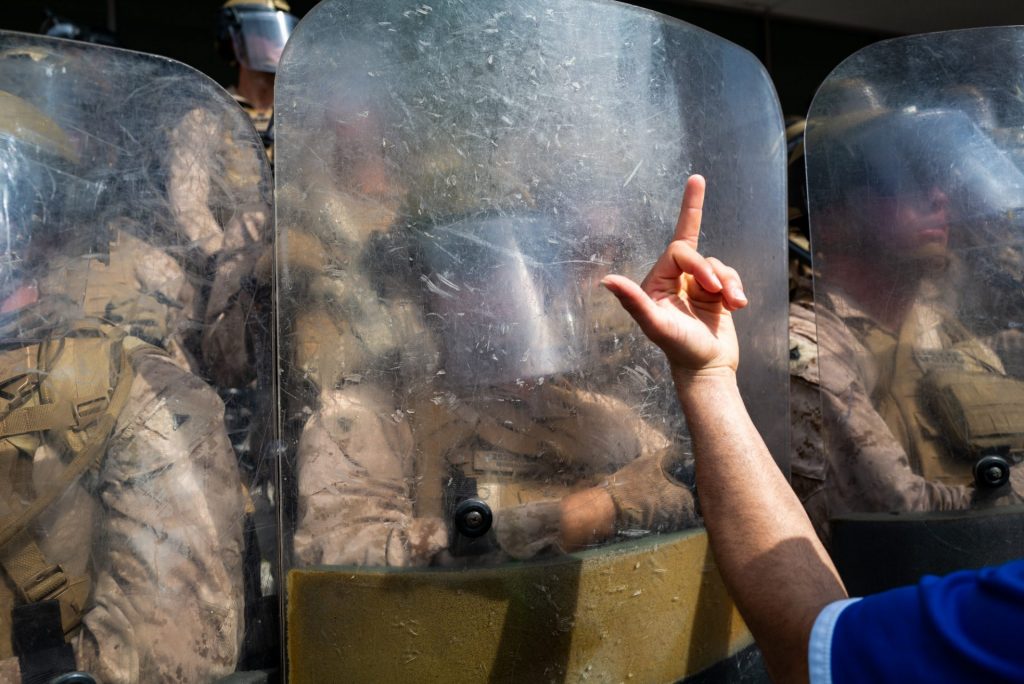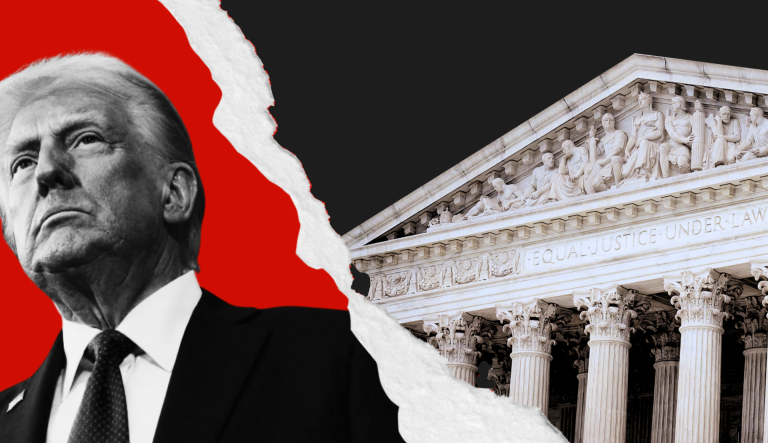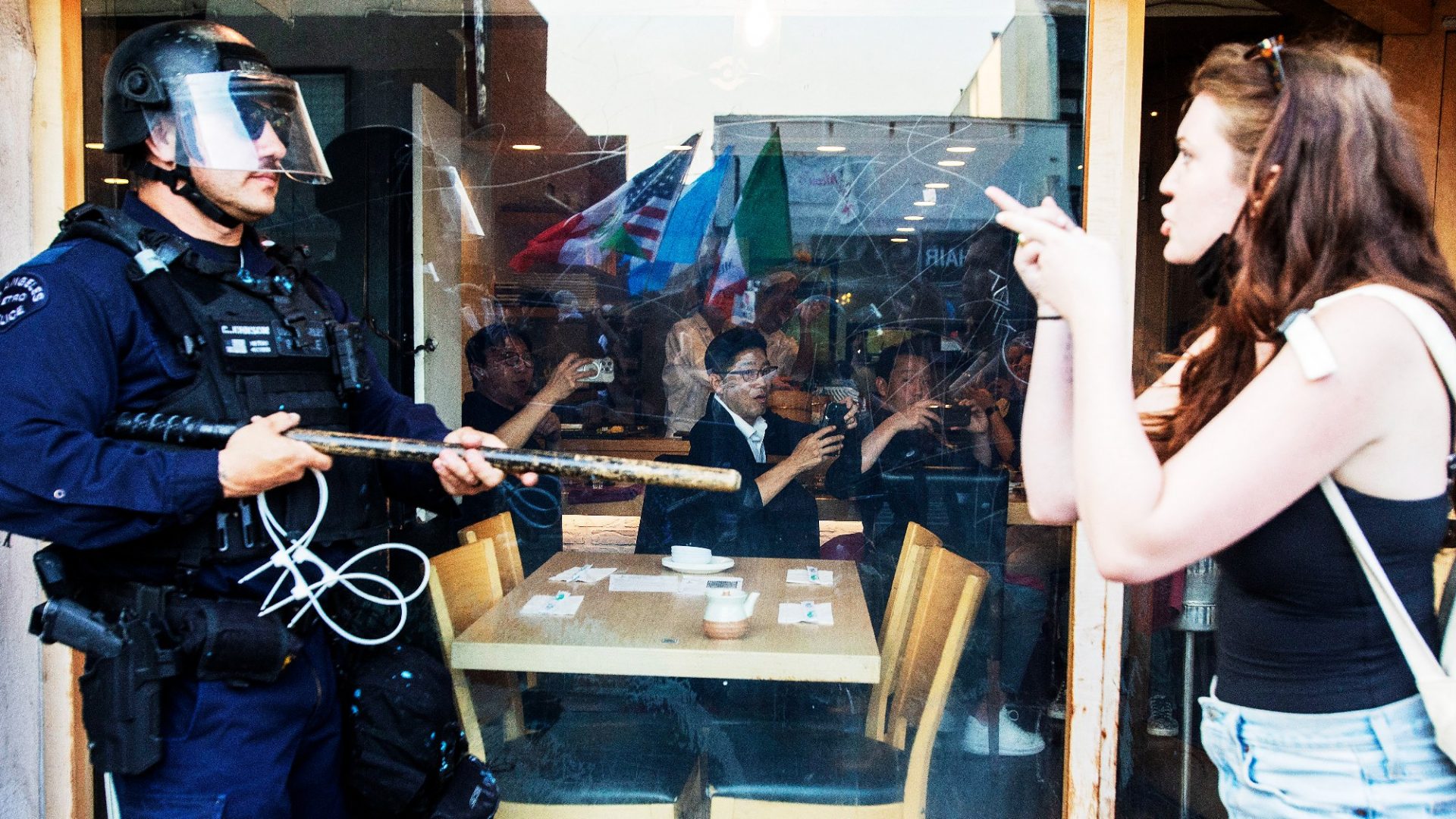Democracy dies in darkness; but it also dies under arc lights. The shots that make a difference are not only those fired from weapons, but also those snatched by phones, posted on X or TikTok, and selected by television producers.
Which is why my heart sank when, early in the Los Angeles disturbances, news channels and social media were flooded with pictures of masked rioters brandishing the Mexican flag, standing beside Waymo self-driving cars in flames.
No president in living memory has had a better instinctive grasp than Donald Trump of the power of the image, carefully curated to generate an emotional charge. There is a reason that, against every rule of traditional politics, a gold-framed reproduction of his arrest mugshot taken at Fulton County Jail in Atlanta, Georgia, in August 2023, now hangs just outside the Oval Office.
Even as he was hit in the ear by a sniper’s bullet at Butler, Pennsylvania, in July 2024, he resisted the secret service’s bid to get him to safety long enough for AP’s Evan Vucci to take a photograph that captured his personal defiance – and serendipitously evoked the legendary picture of US Marines raising the flag at Iwo Jima.
Since US Immigration and Customs Enforcement (ICE) agents launched their raids on LA workplaces and began seizing allegedly undocumented migrants on June 6, the Trump administration has been choreographing a brutal pageant of violence, political theatre and autocratic ambition. Most of the protests in response have been peaceful, just as much of the city has carried on with its day-to-day business. In the same spirit, millions of Americans participated on Saturday in the “No Kings” rallies across the nation, with only a handful of disorderly incidents.
Yet – depending on the source of your news – you might have formed a very different impression. You might, indeed, believe the US to be on the brink of anarchy.
We live in an age of so-called “digital witnessing”. Pressed on his plan for mass deportation by NBC’s Kristen Welker in December, Trump revealingly leapt over ethical, logistic and legal issues to the question of optics.
“I’ll tell you what’s going to be horrible,” he said. “When we take a wonderful young woman who’s with a criminal. And they show the woman, and she could stay by the law, but they show the woman being taken out. Or they want her out, and your cameras are focused on her as she’s crying as she’s being taken out of our country.”
Thus does the president understand the battlelines of his strategy. His question was, and is: what will the voters see? Masked ICE agents in Los Angeles, quite unnecessarily supported by 2,000 members of the National Guard and 700 marines, firing rubber bullets, flash bangs and tear gas, arresting employees at their places of work, breaking up families? Or hooded rioters throwing Molotov cocktails, hammering curbstones to make rock projectiles, and looting stores?
In the main, the US public’s perception of what has happened in LA over the past fortnight will have been driven by algorithm: which is to say, by what they think already (or, in American political idiom, by their “priors”). Progressives will see heart-rending footage of xenophobic, authoritarian cruelty; MAGA supporters will be fed menacing images of mob violence. In this sense, the public space is now governed by the logic of the video game: you choose from a range of realities on offer and respond accordingly.
What is certain is that the Trump administration orchestrated this conflict. As the Wall Street Journal disclosed last week, Stephen Miller, White House deputy chief of staff, held a meeting in late May with assembled ICE chiefs from across the US, at which he signalled a shift in tactics.
In the first four months of Trump’s second presidency, agents had targeted violent criminals and gang members for deportation.
Now, Miller told them, the net was to be cast more widely. “Just go out there and arrest illegal aliens,” he reportedly told them – mindful of the objective he and Kristi Noem, the homeland security secretary, had set of one million expulsions this year. Miller gave specific instructions for Home Depot and 7-Eleven stores to be raided.
On May 30, Tom Homan, the president’s border czar, was also quite clear about his intentions in an interview with the right wing podcaster Vince Coglianese.
“California’s a problem… the whole state’s a sanctuary,” he said, “and Governor [Gavin] Newsom is one of these governors that vilify ICE every day, so it makes the job more difficult… we’re going to concentrate on work-site enforcement, because we have the right to that with no court injunctions on that… We have a big footprint there already but we’re going to double that footprint.”

In Newsom, the administration believed it had selected what Tom Nichols, the US academic specialist in military strategy, calls a “cooperative adversary”: which is to say, an opponent who would take the bait. National Guard units are under state control, unless the president takes the extremely rare decision to federalise them, almost always at the governor’s request.
Not since 1965, when Lyndon Johnson overruled George Wallace to protect civil rights marchers in Alabama, has a president gone over a governor’s head in this fashion. Trump’s legal justification for federalising the National Guard against Newsom’s wishes was flimsy at best. But he was counting on the governor reacting in a particular way.
“[T]his isn’t just about protests here in Los Angeles,” he said. “When Donald Trump sought blanket authority to commandeer the National Guard, he made that order apply to every state in this nation. This is about all of us. This is about you. California may be first, but it clearly will not end here. Other states are next.”
To be clear: Newsom was absolutely correct. Trump’s order is indeed alarmingly generalised and self-evidently drafted to militarise future deportation operations. It opens the door to the invocation of the 1807 Insurrection Act, which would enable the National Guard not only to protect federal buildings and activities but to participate in arrests, detentions and expulsions.
Equally, what the furious Democratic governor delivered was precisely the framing that MAGA had wanted: the crisis in LA as a pilot experiment in the future of migration, citizenship and nationhood. Arguably, he had no option but to react as he did. Trump, after all, had launched the second phase of his mass deportation campaign in his state, spread mayhem and apparently exceeded his legal powers (a question that, at the time of writing, is still being tested in the courts).
But the White House also knew that the governor, and prospective Democratic presidential contender in 2028, would be unable to contain himself. So when Homan appeared to threaten him with detention, Newsom lost his cool: “Come and arrest me! Let’s just get it over with, tough guy! I don’t give a damn.” It is possible to feel sympathy for this entirely human response while acknowledging that it was the rhetorical escalation that MAGA had been seeking all along.
The much greater problem is that Trump has a quite explicit mandate for his appalling programme of mass deportation. In the campaign, he repeatedly declared his ambition to eclipse Eisenhower’s notorious “Operation Wetback” of 1954-55, in which the Border Patrol claimed to have expelled nearly 1.2 million Mexicans. At rally after rally, Trump promised to deport between 10 and 20 million undocumented migrants. It is simply not true that “nobody voted for this”.
To which end: the One Big Beautiful Bill being considered by the Senate earmarks no less than $185bn for immigration enforcement. The question is how far the public, having returned Trump to the White House, is now ready to go along with his plan and the grotesqueries it involves.
As all autocrats do, he and his team are mutilating language to refashion reality. In a quite disgraceful speech at Fort Bragg in North Carolina on June 10, he promised that “we will liberate Los Angeles and make it free, clean, and safe again” and that “we will not allow an American city to be invaded and conquered by a foreign enemy”.
To suggest that the people now being targeted by ICE in LA are “invaders” or prospective “conquerors” is clearly deranged. Yet this is how the US commander-in-chief saw fit to rally the troops at a military base, deriding Joe Biden, the media and “radical left lunatic” politicians. “You know what November 5 was?” he declared. “It was the election of a president that loves you.”
Suggested Reading


Trump’s war against the law
This was a new low for a president who specialises in new lows: a bid to make soldiers who have sworn to uphold the US Constitution believe that their true loyalty is to him; that the armed forces are the military wing of MAGA. Reportedly, 82nd Airborne Division personnel were also instructed that the staging of the event must match the president’s aesthetic demands: “No fat soldiers.”
On Thursday, at a news conference in LA, secretary Noem used similarly debased language. “We are staying here to liberate the city from the socialists,” she said, “and the burdensome leadership that this governor and that this mayor have placed on this country and what they have tried to insert into the city.”
What happened next was a grim augury. Alex Padilla, the senior senator for California and ranking member of the judiciary subcommittee on border security and immigration, identified himself and attempted to ask Noem a question – and was wrestled to the ground, handcuffed and led away.
In response, speaker Mike Johnson did not defend the legislature against these police state methods. Quite the opposite, in fact. “I think that that behaviour, at a minimum, rises to the level of a censure,” he told reporters. “We’re not going to have branches [of government] fighting physically and having senators charging cabinet secretaries.”
Padilla, it should be emphasised, did not “charge” Noem. But why let facts get in the way of MAGA fantasy?
On June 9, the movement’s Svengali, Steve Bannon, explained the crisis thus: “The third world war is not just in the drone attack in Kyiv over the weekend, it’s not just the situation in Israel and Gaza… it’s a political, cyber, psychological, economic warfare that has now got into its kinetic phase. What’s happening in Los Angeles and in San Francisco last night is the beginning of the kinetic phase here in the United States.”
As so often with Bannon, there is a germ of truth amid the nonsense. As the US retreats from the global military stage, its armed services are being stealthily repurposed as the largest private militia in history.
The absurd parade through Washington DC on Saturday – craved by Trump since he returned from a Bastille Day celebration in France in 2017 – was not principally intended to terrify America’s foreign enemies. Held on the president’s 79th birthday, it was meant to align the US military inextricably with his patrimonial leadership and his private whim.
The day was horribly overshadowed by yet another case of political violence: the murder of Democratic representative Melissa Hortman and her husband Mark and the serious wounding of state senator John A Hoffman and his wife, Yvette, at separate locations in Minneapolis. On Sunday, the suspect, Vance Boelter, aged 57, was arrested near Green Isle, Minnesota, after a two-day manhunt – though, at the time of writing, his alleged motives remain opaque.
What is grimly clear is that Trump is content for America to descend into a state of intermittent civil strife, posturing as the defender of order against the chaos which he himself does so much to generate. He has, after all, declared no fewer than eight national emergencies to date, notably in his justification for sweeping tariffs; most ludicrously, he has claimed on Truth Social that even foreign movies represent “a National Security threat”.
And – of course – violence is permissible when enacted in his name. This is the enduring message of his pardon of more than 1,500 January 6 convicts, back on the streets and in debt to the leader who incited them to storm the US Capitol in 2021.
With every fibre of his being, the president seeks to convey strength. Yet, as Hannah Arendt warned in On Violence (1970), recourse to brutality is ultimately a sign of decline: “Rule by sheer violence comes into play where power is being lost… impotence breeds violence”.
Thus is the future of the republic being decided by a battle between narrative and counter-narrative. This battle will not be linear or tidy: that is not how dystopia arrives.
The ratchet turns. Horizons shrink. Citizen fears citizen, and the constitutional loyalties of the past melt into a shabbier allegiance to tribe and faction. Trump has already changed America in so many ways; one thing he has certainly not done is make it great again.




